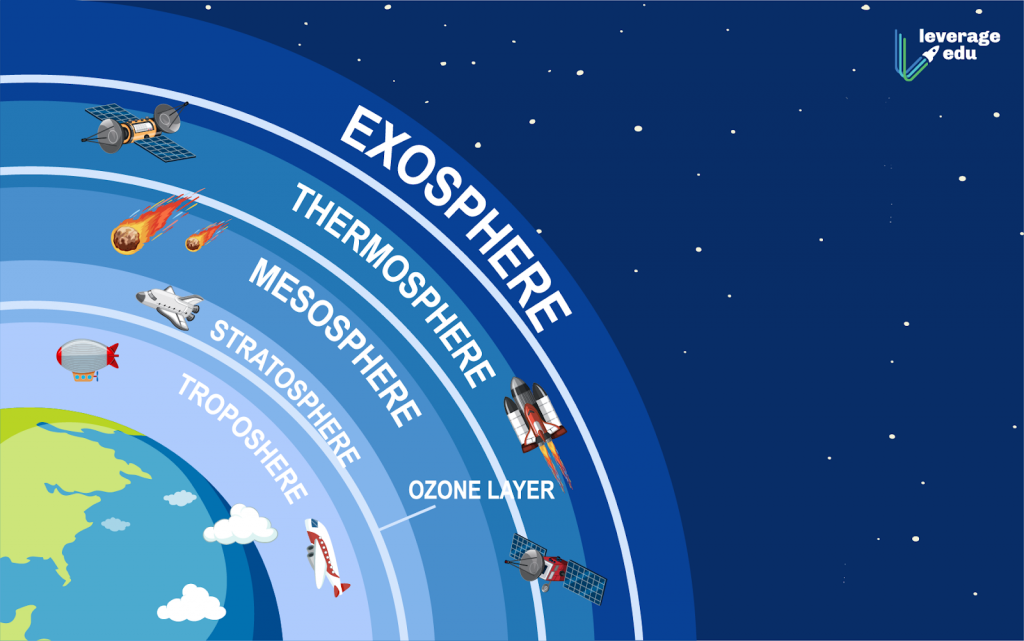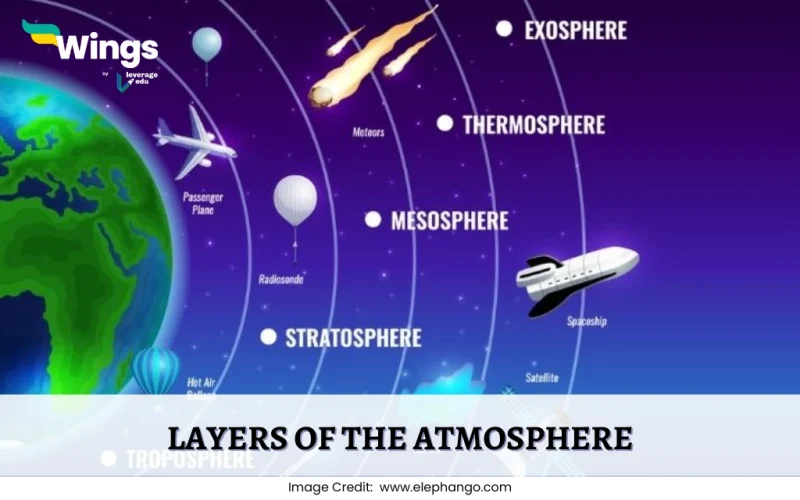Our planet Earth is surrounded by a gaseous layer called the Atmosphere, which is divided into various other layers. The layer of the Atmosphere is an integral topic for the geography section of competitive exams like the SAT, SSC CGL, RRB or other scholastic exams. Hence, all the aspirants must thoroughly prepare for this topic. If you are looking for some quick revision or want to learn more about the layers of the atmosphere, then this blog is going to end your search!
This Blog Includes:
What is the Atmosphere?
The atmosphere can be defined as a layer of gases that surrounds the planet Earth or any other celestial body which comprises a sufficient mass. From the surface of the Earth, the atmosphere extends up to 1000 km. However, almost the entire mass of the atmosphere can be experienced within 32 KM because of the strong gravitational pull of the Earth. This layer of the atmosphere comprises various gases at different proportions, like Nitrogen 78% and Oxygen 21%, the remaining 1% includes gases like Argon, Carbon dioxide, Neon, Helium, etc.

Now that you are familiar with the layers of the atmosphere, let us study them one by one in detail.
Layers of the Atmosphere
Earth’s atmosphere divided into five primary layers based on temperature variations, composition, and other properties. These layers, from lowest to highest, are the troposphere, stratosphere, mesosphere, thermosphere, and exosphere. Each layer of atmosphere plays a unique role in protecting the planet and influencing daily life.
To summarize the key characteristics, here’s a quick comparison table of layers of the atmosphere:
| Layer of atmosphere | Height Range (km) | Temperature Range (°C) | Key Features |
| Troposphere | 0-12 (average) | 15 to -56 | Weather occurs; contains 75-80% of atmospheric mass |
| Stratosphere | 12-50 | -56 to -2 | Ozone layer absorbs UV; stable for aircraft |
| Mesosphere | 50-85 | -2 to -90 | Meteors burn up; coldest layer |
| Thermosphere | 85-600 | Up to 2,000+ | Auroras; high-energy absorption |
| Exosphere | 600-10,000 | Varies widely | Merges into space; satellites orbit |
Also Read: What Is an Autobiography? Meaning, Writing Tips, and Examples
Now that you are familiar with the atmosphere, let us study the various layers of the atmosphere.
Troposphere
The Troposphere is the lowest layer of Earth’s atmosphere, which extends from the surface to about 7 to 20 kilometres. This is the space where we live, and most of the weather phenomena occur. Here are some of the important points about this layer:
- Extending up to 18 km in height, it is the first layer of the atmosphere at the equator and 8 km at the poles.
- In the Troposphere, the temperature decreases with height; hence, the density of the air decreases with an increase in height, i.e., less heat is absorbed.
- The Troposphere contains more than 90% of the total gases of the atmosphere.
- ‘Tropo’ means Change, as almost all the weather changes occur in this layer due to the formation of clouds from the water vapour.
- Tropopause: The maximum height where the temperature stops decreasing. The temperature here can go as low as -58 degrees Celsius.
Why Does the Troposphere Get Warmer Near the Ground?
Despite the fact that sunlight strikes the Earth’s surface from top to bottom, the troposphere is heated most intensely there. The surface of the Earth is far more effective than the air at absorbing a variety of solar energy. The heated air packet expands as it rises, and when air expands, it cools. Because of this, the base of the troposphere is warmer than its base because the air on Earth’s surface absorbs solar energy, warms up, and rises upward, where it cools down.
Stratosphere
The stratosphere is the second layer of the Earth’s atmosphere, which is situated above the troposphere and below the mesosphere. Here are some of the important points about the stratosphere:
- This is the second layer of the atmosphere and ranges from about 12-50 kilometers the Troposphere.
- Out of all the layers of the atmosphere, the Stratosphere is the most beneficial as it absorbs the Ultraviolet (UV) radiation from the Sun because of the presence of ozone in it.
- As compared to the layer beneath it, this layer is warmer and has a temperature of around 4 degrees Celsius.
- The layer provides ideal conditions for flying fighter jet planes as it is free from clouds and weather phenomena.

What Causes the Stratosphere to Be Warmer Than the Troposphere?
The sun’s intense UV radiation is absorbed by ozone molecules in the stratosphere and transformed into heat. The stratosphere warms up as you ascend, for this reason, unlike the troposphere.
Mesosphere
The Mesosphere is the third layer of Earth’s atmosphere, which is situated between the stratosphere and thermosphere. This layer extends about 50 to 85 kilometres above the surface. Here are the important points about the mesosphere:
- Extending to a height of 80 KM above the Stratosphere lies the Mesosphere.
- It is one of the coldest layers of the atmosphere with a temperature rising up to -90 degrees Celsius.
- Meteors burn up in this layer.
- It is difficult to breathe in this layer as the air is thinnest with the bare minimum pressure in it.
- No aeroplanes, fighter jets, or hot air balloons can fly this high to reach this layer.
Why Would the Mesosphere Make the Blood Boil in an Unprotected Astronaut?
Because the ozone layer that gives UV protection is in the stratosphere, below, an astronaut travelling through the mesosphere would suffer severe burns from the sun’s ultraviolet rays. As they enter the atmosphere from space, meteorites ignite in this layer.
Can We Live in the Mesosphere?
No. The mesosphere is not a place where humans can live. The mesosphere is situated between the stratosphere and the thermosphere. That is around 50–85 km above Earth. It’s the place where meteors can burn up. However, the temperature can drop to –90°C. There is not enough oxygen in the atmosphere for us to breathe. Moreover, the pressure is so low that we need a pressure suit to function properly.
Thermosphere
The Thermosphere is a layer of Earth’s atmosphere which is located above the mesosphere and below the exosphere. This layer is known as the hottest layer of the atmosphere and temperatures can soar to 500-2,000°C or higher, varying with solar activity. Here are some of the points about the thermosphere:
- The Thermosphere is found exactly above the Mesosphere with a height of 640 KM.
- The temperature in this layer increases with height as the gas molecules present in this layer absorb the UV radiation and the X-rays from the sun.
- Amongst all the layers of atmosphere, this layer helps in long-distance communication as the electrically charged gas particles present in the Thermosphere reflect back the radio waves from the Earth to space.
- This layer also protects the Earth from the huge meteors and satellites.

Can We Live in the Thermosphere?
No. Humans can’t live in the thermosphere. Our current technology doesn’t allow us to live in the thermosphere. This is because the atmospheric air that starts 80km above the surface of the Earth has extremely thin air and high temperatures. The temperature can reach up to 2,500°C (4,500°F). However, the air is so cold that you will not feel the warmth even in those temperatures! Therefore, the thermosphere is ideal for satellites and space shuttles, and not for humans.
Also Read: Popular Visual Arts Courses Abroad
Exosphere
The exosphere is the outermost layer of the Earth’s atmosphere, which is characterised by extremely low gas density and particles that escape into space. Look at some of the pointers about this layer:
- It is the outermost layer of the atmosphere and extends up to 640 KM in height.
- The temperature of this layer is quite high and ranges between 300 degrees Celsius to 1650 degrees Celsius.
- As the height of the layer increases, it slowly merges into the interplanetary space.
- The layer contains the least amount of gases like Oxygen, Argon, Helium etc., because the particles of the gases escape to space due to the bare minimum presence of gravity.

Is the Exosphere Hot or Cold?
The exosphere is both hot and cold. The outermost layer of the surface of the Earth, where the molecules and the atoms drift into space, can be hot due to solar radiation. However, since the particles are spread apart, there is no thermal contact. Therefore, you will feel cold. In short, the exosphere is a place where you will feel extreme temperatures and less heat sensation.
FAQs
The different layers of the atmosphere are the troposphere, Stratosphere, Mesosphere, Thermosphere, and Exosphere. These layers are like a blanket covering and protecting the Earth and helping the planet to sustain life.
There are five layers of the atmosphere. They are the Troposphere, Stratosphere, Mesosphere, Thermosphere, and Exosphere. Each of these layers has a different pressure, temperature, and composition that serves a different function in the atmosphere.
The coldest layer is the Mesosphere. Here, the temperature can go down up to –90°C (–130°F), particularly in high altitudes. This is also the region where the meteors burn before reaching the surface of the Earth.
The layer that is the closest to space is the exosphere It starts about 600 km above Earth and transitions in the vacuum of space. This layer has thin air. Here, atoms drift to space and few can even collide. This region is above the grasp of gravity.
The outermost layer of the Earth is the crust. It is the thinnest layer of the Earth. It is only T 3-5 miles (8 kilometres) thick.
Related Reads:
Hope you liked reading our blog about the layers of atmosphere. For more information about study abroad, you can get in touch with Leverage Edu. Stay tuned with Leverage Live classes and realise your dream of studying abroad

 One app for all your study abroad needs
One app for all your study abroad needs





















 45,000+ students trusted us with their dreams. Take the first step today!
45,000+ students trusted us with their dreams. Take the first step today!


